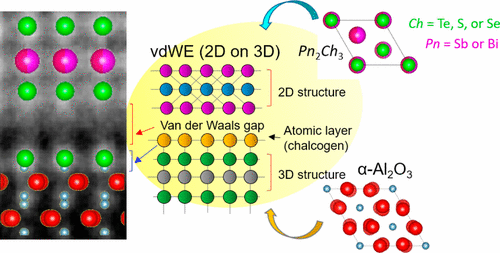当前位置:
X-MOL 学术
›
Nano Lett.
›
论文详情
Our official English website, www.x-mol.net, welcomes your
feedback! (Note: you will need to create a separate account there.)
Te Monolayer-Driven Spontaneous van der Waals Epitaxy of Two-dimensional Pnictogen Chalcogenide Film on Sapphire
Nano Letters ( IF 9.6 ) Pub Date : 2017-09-15 00:00:00 , DOI: 10.1021/acs.nanolett.7b02737 Jae-Yeol Hwang 1 , Young-Min Kim 1, 2 , Kyu Hyoung Lee 3 , Hiromichi Ohta 4 , Sung Wng Kim 1
Nano Letters ( IF 9.6 ) Pub Date : 2017-09-15 00:00:00 , DOI: 10.1021/acs.nanolett.7b02737 Jae-Yeol Hwang 1 , Young-Min Kim 1, 2 , Kyu Hyoung Lee 3 , Hiromichi Ohta 4 , Sung Wng Kim 1
Affiliation

|
Demands on high-quality layer structured two-dimensional (2D) thin films such as pnictogen chalcogenides and transition metal dichalcogenides are growing due to the findings of exotic physical properties and potentials for device applications. However, the difficulties in controlling epitaxial growth and the unclear understanding of van der Waals epitaxy (vdWE) for a 2D chalcogenide film on a three-dimensional (3D) substrate have been major obstacles for the further advances of 2D materials. Here, we exploit the spontaneous vdWE of a high-quality 2D chalcogenide (Bi0.5Sb1.5Te3) film by the chalcogen-driven surface reconstruction of a conventional 3D sapphire substrate. It is verified that the in situ formation of a pseudomorphic Te atomic monolayer on the surface of sapphire, which results in a dangling bond-free surface, allows the spontaneous vdWE of 2D chalcogenide film. Since this route uses the natural surface reconstruction of sapphire with chalcogen under vacuum condition, it can be scalable and easily utilized for the developments of various 2D chalcogenide vdWE films through conventional thin-film fabrication technologies.
中文翻译:

单层驱动的蓝宝石上二维光子原硫属元素化物薄膜的自发范德华外延。
由于发现了奇异的物理性能和器件应用的潜力,对高质量层结构的二维(2D)薄膜(如光致硫属元素化物和过渡金属二硫属化物)的需求正在增长。但是,在二维(3D)基板上控制2D硫族化物薄膜的外延生长的控制困难和对范德华外延(vdWE)的理解不清,一直是2D材料进一步发展的主要障碍。在这里,我们利用了高质量2D硫族化物(Bi 0.5 Sb 1.5 Te 3)通过硫族元素驱动的传统3D蓝宝石衬底表面重建而制成的薄膜。证实了在蓝宝石表面上原位形成假晶Te原子单层,导致无悬空的键合表面,使得2D硫族化物膜具有自发的vdWE。由于该路线在真空条件下使用硫属元素对蓝宝石进行自然表面重建,因此可以通过常规薄膜制造技术对其进行扩展,并轻松用于各种2D硫属元素化物vdWE膜的开发。
更新日期:2017-09-15
中文翻译:

单层驱动的蓝宝石上二维光子原硫属元素化物薄膜的自发范德华外延。
由于发现了奇异的物理性能和器件应用的潜力,对高质量层结构的二维(2D)薄膜(如光致硫属元素化物和过渡金属二硫属化物)的需求正在增长。但是,在二维(3D)基板上控制2D硫族化物薄膜的外延生长的控制困难和对范德华外延(vdWE)的理解不清,一直是2D材料进一步发展的主要障碍。在这里,我们利用了高质量2D硫族化物(Bi 0.5 Sb 1.5 Te 3)通过硫族元素驱动的传统3D蓝宝石衬底表面重建而制成的薄膜。证实了在蓝宝石表面上原位形成假晶Te原子单层,导致无悬空的键合表面,使得2D硫族化物膜具有自发的vdWE。由于该路线在真空条件下使用硫属元素对蓝宝石进行自然表面重建,因此可以通过常规薄膜制造技术对其进行扩展,并轻松用于各种2D硫属元素化物vdWE膜的开发。










































 京公网安备 11010802027423号
京公网安备 11010802027423号